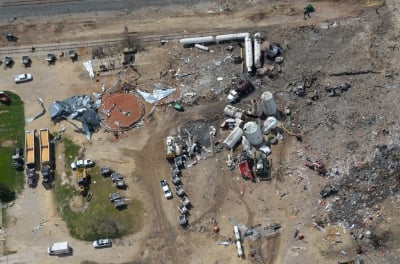For over 20 years, OSHA's process safety management (PSM) standard worked to guarantee safe and healthy workplaces in industries that use hazardous chemicals. For most of that time the standard had remained largely unmodified. This all changed last year.
Executive Order 13650 (Improving Chemical Facility Safety and Security) was signed shortly after the West Fertilizer Company incident occurred on April 17, 2013. After the incident, it was recognized by authorities that, among other regulations, OSHA's PSM standard was outdated and did not account for the many factors that have contributed to plant incidents since the original OSHA PSM standard was created in 1992.

Aftermath of the West Fertilizer Incident that occured on April 17, 2013
The Order called for a request for information (RFI) to be published by OSHA within 90 days. OSHA published the RFI on December 9, 2013 and asked for all comments to be submitted by March 31, 2014. From the comments recieved several areas were suggested for revision. This blog post will briefly discuss the areas suggested for revision and provide some helpful resources that you can follow to stay up to date.
Areas suggested for revision
The following 15 suggestions have been put forth for revision of the PSM standard:
- Clarifying the PSM exemption for atmospheric storage tanks, as PSM has not been sufficient to safeguard against their catastrophic hazard potential.
- Eliminating the PSM exemption for oil and gas well drilling and servicing operations and proceeding with the economic analysis necessary to enforce PSM at oil and gas well drilling & servicing and production facilities.
- Expanding PSM coverage and requirements for reactivity hazards that could have catastrophic consequences.
- Updating the list of highly hazardous chemicals in appendix A of the PSM standard. 167 serious incidents occured in the United States between January 1980 and June 2001 involving uncontrolled chemical reactivity, resulting in 108 fatalities. More than half of these incidents involved chemicals that were not covered by OSHA’s PSM standard.
- Revising the PSM standard to require additional management system elements.
- Amending paragraph (d) of the PSM standard to require evaluation of updates to applicable recognized and generally accepted good engineering practices (RAGAGEP).
- Clarifying the PSM standard by adding a definition for RAGAGEP.
- Expanding the scope of Paragraph (j) of the PSM standard to cover the mechanical integrity of any safety-critical equipment. Rather than using a list-based approach, it is suggested that the PSM standard should require companies to identify their safety critical equipment/elements (SCE) and demonstrate to the regulator that each SCE has a performance standard that addresses functionality, availability, reliability, survivability, and interactions with other systems as well as a verification scheme.
- Clarifying paragraph (l) of the PSM standard with an explicit requirement that employers manage organizational changes that may impact process safety including major organizational changes such as mergers, acquisitions, or reorganizations, personnel changes, and policy changes such as budget cutting
- Revising paragraph (n) of the PSM standard to require coordination of emergency planning with local emergency-response authorities. A pre-incident plan is needed to provide clear and adequate information on the magnitude of hazards in a chemical plant or other business containing highly hazardous chemicals, which can be easily understood by firefighters and other emergency responders.
- Revising paragraph (o) of the PSM standard to require third-party compliance audits. OSHA wants to require employers to use a qualified third party for PSM compliance audits.
- Expanding the requirements of 1910.109 to cover dismantling and disposal of explosives, blasting agents, and pyrotechnics.
- Updating the Flammable Liquids standard (sections 1910.106 and 1910.107) based on the latest applicable consensus standards.
- Updating the regulations addressing the storage, handling, and management of ammonium nitrate because of its known physical characteristics and hazardous properties.
- Changing the enforement policy for Highly Hazardous Chemicals listed in Appendex A of the PSM Standard without specific concentrations.
Helpful resources
We recommend referring to the following websites to learn more about the Executive Order:
- OSHA's Executive Order 13650 Homepage contains the most recent status reports and progress updates, as well as a background on the order.
- Public comments on OSHA's PSM request for information.
- The US Chemical Safety and Hazard Investigation Board's (CSB's) response to OSHA's RFI.
Inspectioneering will continue to monitor the progress of Executive Order 13650 and the revisions to the OSHA Process Safety Management standard. If you'd like to receive Inspectioneering's updates on a periodic basis, click the button below to sign up for our weekly newsletter.
















Comments and Discussion
There are no comments yet.
Add a Comment
Please log in or register to participate in comments and discussions.